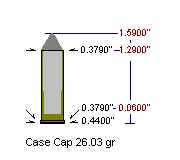Fire ArmBarrel Twist Optics Distance Shots |
: Marlin 1894cs: 18.5 inches : 1:16 inches
: 24 X : 50 yards : 10 |
 Click on figure to access ANSI technical cartridge drawing |
The 357 in a lever gun makes an excellent small game and varmint gun, and in the hands of a skilled hunter, a close range (less than 50 yards) deer gun - noting that handgun bullets have poorer ballistic coefficients than comparable rifle hunting bullets, and as such will lose energy quickly and generate a rainbow trajectory. The 357 launching 110 or 125 grain JHPs in excess of 2200 fps make excellent varmit zappers. The 180 grainers can be launched slow as target rounds, or over 1600 fps as non-expanding hunting rounds.
Historically, the 357 is significant in that it represents the first of only two major cartridge design rule changes this century - previously handgun cartridges had been designed to 14000 to 16000 CUP. (The second major rule change has been the post-wonder-nines semiauto cartridges: designed to maximize velocity/kinetic energy for very very specific applications - the 40 S&W, the 9x21 etc.) The 357 case is a 38 Special case, stretched .135" (yielding 3.9 grs of capacity), and beefed up to support the doubled plus pressure rating - 17000 CUP vs 35000 CUP (allowing the 357 to generate 3 to 4 times the energy of a comparable 38 Special round). Nominal bullet diameter is .357"